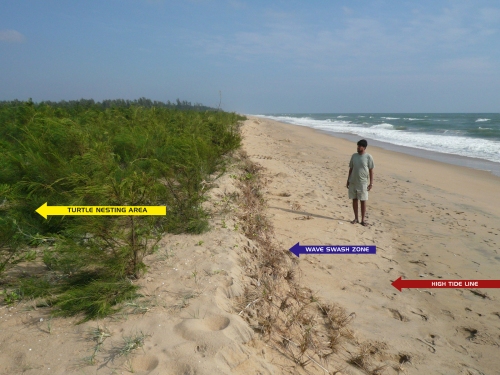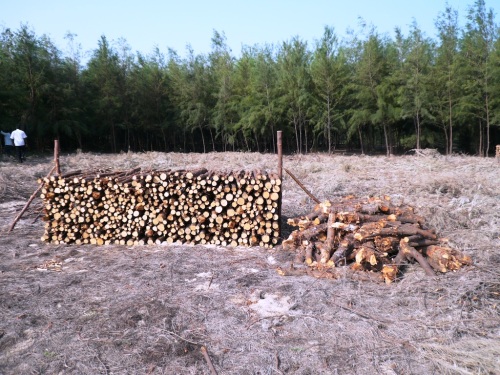After the December 2004 tsunami, the World Bank funded an Emergency Tsunami Reconstruction Project (ETRP) in the southern state of Tamil Nadu. One of the measures implemented at great cost was the raising of ‘bio-shield’ shelterbelts on the beaches, primarily of Casuarina, an exotic fast growing species. The plantations covered over one third of the entire Tamil Nadu coast, and had been established up to the high tide line, thereby completely eliminating large stretches of sea turtle nesting habitat.
The Casuarina plantations were apparently raised to protect fishing communities and other humans living on the coast from tsunamis and cyclones. Our surveys, however, showed that most of these communities had insisted that no trees be planted on the beachfront facing their habitations, as that would obscure their view of the sea and impede their progress to it. The irony of this ETRP shelterbelt project was that the only areas that actually needed some form of protection from tsunamis were the areas devoid of plantations.
Soon after the tsunami, a study was done by the MS Swaminathan Research Foundation (MSSRF) on the efficacy of shelterbelts in tsunami impact mitigation. The results of this study clearly stated that Casuarina plantations very close to the high tide line can cause severe, irreparable erosion of the entire coastline, affecting not only turtles and other species but also fishing communities and coastal residents. The problem can only be resolved by removing Casuarina plantations up to at least 50 to 75m from the high tide line.
SSTCN sent a letter to the President of the World Bank, requesting him to take suitable action, that will ensure the removal of the casuarina planted within 50m of the high tide line.
SSTCN also asked for the World Bank to ensure that in the future, such shelterbelt projects and other projects that will impact natural ecosystems are scientifically assessed before funding and carefully and independently monitored during implementation.
Following the letter to the World Bank, there was a call from the WB office in New Delhi and a visit to Chennai by Mr Christoph Pusch, Regional Coordinator of South Asia, Hazard Management, and Ms Ranu Sinha, Consultant, Hazard Management. The two of them met SSTCN members, and during the meeting, promises were made to immediately make arrangements to remove the casuarina in the 50m closest to the high tide line.
Subsequently, the WB officials met the Forest Department, who engaged an organization – Tree Foundation, to submit a report on casuarina plantation. Tree Foundation gave in their report, which stated that Casuarina has to be removed to at least 45m from the high tide line.
The matter did not end there, and needed more than a year of intense lobbying and sustained follow-up by SSTCN. At last, senior officials in the Government who clearly understood the negative impacts of the ETRP, managed to have a Government Order passed on 5th September 2008 that directed the Principal Chief Conservator of Forests to remove the casuarina trees from the beaches in order to ensure that the olive ridley sea turtle, a Schedule 1 species, is able to nest there once again.
It is heartening to note that the difficult and challenging work of removing these fast growing trees along with their roots has now been done. Officials within the Forest Department worked very hard to completely clear the casuarina, for up to a distance of more than 15m from the high tide line. As a result, the native vegetation consisting of ipomoea and spinifex and the native fauna consisting of different species of crabs, small reptiles and birds gradually returned. Studies have shown that the endangered olive ridley turtles which have been nesting on our shores for millions of years are coming back to nest here once again.



